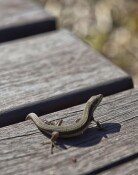Museum Excavators Discover Ship from the Past
Museum Excavators Discover Ship from the Past
Posted August. 25, 2005 02:59,
A Korean ancient ship has been discovered in the country, and excavations have already been started to unearth this vessel, which is said to be the biggest and the most well-preserved among the ships already found.
An excavation team from the Korean National Maritime Museum started an investigation at the coast of Anjwa Island starting August 5 and found a traditional Korean vessel presumed to have come from the late Goryeo Dynasty, somewhere around the 13th to 14th century. This triumph came in just six months after the residents of the island reported in early February that a boat seemed to be buried in the lagoon.
This ship is approximately 14.5 meters long and 6.0 meters wide (currently, only 4.5 meters in width seems to be left). The bow, stern and the baseplate are all still remaining, making it the largest and the most well-preserved ship among excavated ancient Korean vessels.
Up until now, only three ancient Korean ships (except canoes), vessels found in Wando and Sibidongpa Island of the 11th Century, and a 14th Century Dalrido vessel, were found, which were approximately 10 meters in length. The Anjwa vessel was the first ship to be found with its head, stern, and baseplate all in one piece.
Moon Hwan-seok, the head of the cultural research department at the museum, said, Judging by the general structure and the clay jars found on the ship, we think it is from the late Goryeo Dynasty. Part of the outside plates is missing, but the ship seems to be in good shape. This will become important research material on traditional Korean ships.
It was confirmed that this ship also had a mast holder and a mainstay. Lee Cheol-han, a researcher at the maritime museum, said, Traditional Korean ships usually put the mast at the bottom of the ship, but this is the first one found to have a separate mast holder.
Along with the ship, entwined arrowroot vines (five centimeters in diameter) used as the ship ropes, six clay jars, 130 oak logs, a straw rope (two centimeters in diameter) used to tie up the logs, and a whetstone were discovered.
The excavation team guessed the ship had been a carrier for celadon porcelains. The boat seems to have been shipwrecked in front of Anjwa Island after shipping the celadon from Gangjin, Jeonnam Province to the Gaegyeong (currently, the North Korean city Gaesong), the capital during the Goryeo Dynasty, and returning back to Gangjin.
The team will dismantle the ship and retrieve it around early September, and transfer it to the Korean National Maritime Museum in Mokpo, where it will be desalinated.
Kwawg-Pyo Lee kplee@donga.com







